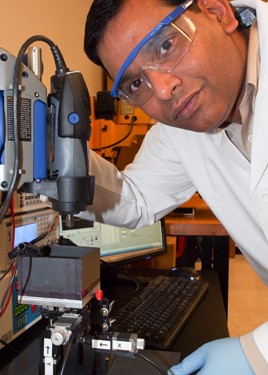
Smallest Workshop Promises Big Benefits in Nano Manufacturing
Murali M. Sundaram has a dream. One day, he hopes to see a low-cost and sustainable manufacturing facility capable of machining all sorts of substances at the smallest scales, without the need for a super-clean laboratory environment.
Success in manufacturing is only possible if the common man is involved, said Sundaram, assistant professor of mechanical engineering in UCs College of Engineering and Applied Science. Sustainability requires low-cost. Investment will follow affordability.
Director of UCs Micro and Nano Manufacturing Laboratory, Sundaram is exploring a variety of cutting-edge processes to be used to machine substances at very small scales. The ability to manufacture at micro-scales and nano-scales has potential application in biomedical, automotive, microelectronics, paintings and coatings, and measurement industries.
The key is to move from the clean room into the real world. Sundaram said. To do that we have to not only develop these processes, but to make them reliable and affordable.
Another goal is to apply processes to a variety of materials. Over the past half-century, silicon has been used in many microelectronic devices, so its properties are widely understood. Sundaram notes that some devices call for materials other than silicon.
When I was student, I often heard, We can do micromachining on any substance as long as it is silicon, Sundaram said. But in the real world we need technologies to micromachine a variety of materials. This was my motivation to explore nontraditional and alternative processes.
Although the processes Sundaram is exploring are often called alternative manufacturing processes, he notes that, for some tasks, the only workable process is an alternative process. A major factor, particularly at nano-scales, is that materials dont behave the same as they do at normal scales.
Lets say I want to write a program for a robot to move an object, Sundaram said. It should be simple. Locate the object, pick it up, move it drop it. However, at the nano-scale, the object will not drop. Gravity is not the major force at that scale.
At nano-levels, properties change. There is much to learn about how materials behave at that scale.
First, I ask what is the difference? Sundaram said. Then, what causes the difference? Then how can I use the difference in manufacturing?
Sundarams lab is engaged in an effort to find a nano-equivalent to common machining techniques like drilling or grinding. There is no nano-equivalent to sandpaper, but tiny particles of diamond can be bounced between an ultrasonically vibrated tool and the workpiece, generating holes smaller than 400 nanometers in diameter. Even here, scale makes a difference.
If I were to drill a hole in a sheet of metal, I would expect that hole to be there next week or next year, Sundaram said. If I make a hole just a few atoms wide, I will find that atoms gradually move into the open space.
Even at this scale, environmental concerns arise. Nano-abrasives may knock nothing larger than a nano-particle from the target, but enough nano-particles eventually add up to an environmental concern.
Working with doctoral candidate Sagil James, Sundaram is exploring green nanomanufacturing technology to monitor and control the production of toxic nanoparticles. The goal is a cost-effective method to monitor and prevent hazardous nanoparticles from entering the ecosystem and adversely affecting the environment.
Related Stories
UC’s Ground Floor Makerspace births combat robots
April 17, 2024
In the heart of UC's 1819 Innovation Hub lies the Ground Floor Makerspace, an advanced and active hub of ingenuity where students, faculty and the community converge to bring their ideas to life. This includes being the birthplace of robots much like miniature race cars, combating fender to fender in an enclosed boxing ring. Combat robots like UC's Maximizer will again be fighting for first place in the National Havoc Robot League (NHRL) competition, slated for April 20.
UC researchers develop new CPAP device
April 17, 2024
Researchers at the University of Cincinnati are developing a VortexPAP machine that takes advantage of vortex airflow technology. A preliminary clinical study with current CPAP users demonstrated that the VortexPAP can deliver the pressure levels that are used in the subjects’ CPAP therapy, but the mask is more comfortable to wear. It has a minimalistic design that is less intrusive and barely touches the patient’s face.
UC architectural engineering alumna inspires high school students
April 16, 2024
University of Cincinnati alumna Emma Wilhelmus fell in love with engineering when she was in ninth grade. After taking drafting, architecture and engineering courses in high school, she set out to major in architectural engineering in college. Now, she is an engineering teacher at a local high school and hopes to inspire students.
